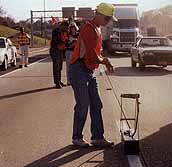
TE-29 : Retroreflectivity
Retroreflectivity: Right Back At You!
 Retroreflectivity, or nighttime visibility of signs and pavement markings,
is recognized as essential for efficient traffic flow, driving comfort, and highway
safety. To help State highway agencies improve the inservice performance of traffic signs
and pavement markings, the Federal Highway Administration has initiated Test and
Evaluation Project 29. The project uses newly-developed retroreflection technology to
efficiently measure the nighttime visibility of signs and pavement markings. The two-part
project addresses the evaluation of retroreflectometer equipment for measuring the
nighttime visibility of signs and pavement markings and the feasibility of establishing
guidelines and their impact on the maintenance operation of State and local highway
agencies. Results of this project should establish appropriate retroreflection guidelines
for signs and pavement markings. The guidelines will help State and local highway agencies
identify and determine when signs and pavement markings have reached the end of their
useful life and need to be refurbished.
Retroreflectivity, or nighttime visibility of signs and pavement markings,
is recognized as essential for efficient traffic flow, driving comfort, and highway
safety. To help State highway agencies improve the inservice performance of traffic signs
and pavement markings, the Federal Highway Administration has initiated Test and
Evaluation Project 29. The project uses newly-developed retroreflection technology to
efficiently measure the nighttime visibility of signs and pavement markings. The two-part
project addresses the evaluation of retroreflectometer equipment for measuring the
nighttime visibility of signs and pavement markings and the feasibility of establishing
guidelines and their impact on the maintenance operation of State and local highway
agencies. Results of this project should establish appropriate retroreflection guidelines
for signs and pavement markings. The guidelines will help State and local highway agencies
identify and determine when signs and pavement markings have reached the end of their
useful life and need to be refurbished. TE-29 is one of three retroreflection projects.
Evaluation of all-weather pavement markings
This project evaluates the visibility, durability, and safety performance of all-weather pavement markings installed by State highway agencies at test sites. These will be evaluated with the mobile pavement marking retroreflectometer.
![]()
FHWA Sign Management and Retroreflectivity Tracking System (SMARTS)
SMARTS is a mobile system used to efficiently and economically measure the retroreflectivity (nighttime brightness) of traffic signs.
The system will track the designated sign, and at 200 feet will illuminate the sign with a powerful flash tube and measure the retroreflectivity of the sign.
A small picture of each sign will be stored in the systems data base, along with GPS coordinates and other data associated with that particular sign. This data will be used to evaluate the quality of the sign, and develop a sign inventory database.
SMARTS' unique feature is that it measures at highway speeds and does not need traffic control to make the measurements. These are major safety advantages over handheld equipment.
SMARTS gives highway agencies the data necessary to schedule timely maintenance of traffic signs on a systemwide basis.
A prototype was built and is being showcased to the highway community at national conferences.
For more information about SMARTS, contact Peter J. Hatzi, HOTO, (202) 366-8036, at the Federal Highway Administration.
- Retroreflectivity Featured Project page
- Retroreflectivity PowerPoint presentation: TE-029 Retroreflectivity Office of Technology Applications
- Retroreflectivity PowerPoint presentation: Raising the Nighttime Brightness of Traffic Signs and Markings
- Retroreflectivity PowerPoint presentation:Sign Retro Reflectometers: How Do They Work?
![]() HIGHWAYTECHNET
HIGHWAYTECHNET ![]() VIRTUAL
EXPO
VIRTUAL
EXPO ![]() SAFETY INDEX
SAFETY INDEX
![]() U.S.
Department of Transportation
U.S.
Department of Transportation
Federal Highway Administration
CLICK FOR INFO   Project Managers Peter J. Hatzi HOTO (202) 366-8036 Ernie Huckaby Jonathan (Dan) Turner Technical Support Contract |